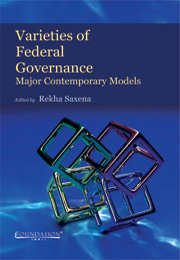Book contents
- Frontmatter
- Contents
- List of Contributors
- Foreword
- Acknowledgements
- Introduction
- I Theoretical and Comparative Dimensions
- II Presidential Federal Systems
- III Commonwealth Parliamentary Federations
- IV Non-Commonwealth Parliamentary Federations in Afro-Asia
- V European Parliamentary Federations
- 15 The German Federal System and its Reforms: Structures, Taboos and the ‘Shylock Principle’
- 16 The Belgian Federation: Tools of Appeasement, Instruments of Confrontation
- 17 Federalism as Ideology and as Institutional Form in the Spanish Estado de las Autonomías (1977–2004)
- VI Devolutionary Systems
- VII Supranational Confederalism/Federalism?
15 - The German Federal System and its Reforms: Structures, Taboos and the ‘Shylock Principle’
from V - European Parliamentary Federations
Published online by Cambridge University Press: 05 June 2012
- Frontmatter
- Contents
- List of Contributors
- Foreword
- Acknowledgements
- Introduction
- I Theoretical and Comparative Dimensions
- II Presidential Federal Systems
- III Commonwealth Parliamentary Federations
- IV Non-Commonwealth Parliamentary Federations in Afro-Asia
- V European Parliamentary Federations
- 15 The German Federal System and its Reforms: Structures, Taboos and the ‘Shylock Principle’
- 16 The Belgian Federation: Tools of Appeasement, Instruments of Confrontation
- 17 Federalism as Ideology and as Institutional Form in the Spanish Estado de las Autonomías (1977–2004)
- VI Devolutionary Systems
- VII Supranational Confederalism/Federalism?
Summary
Introduction: The System and its Reforms
The German federal system has been undergoing numerous changes as per the Federalism Reform Act of September 2006, based on the deliberations of the so-called Federalism Reform Commission I (Kommission von Bundestag und Bundesrat zur Modernisierung der bundesstaatlichen Ordnung – Bundesstaatskommision). Further alterations in the financial area followed after a Federalism Reform Commission II reported in March 2009. These changes and the further plans are still and will continue to be the subject of much public and scientific debate and controversies.
Such controversies cen'tre around criticisms to the effect that the changes are incomplete and inadequate because as in previous reform efforts they suffer from several taboos, which were self-imposed in both Reform Commissions and which are outlined here in the context of the financial constitution and above all in the last part of this chapter. Due to those taboos, it is said, the changes have made and will make the federal system even more intransparent and inefficient rather than improving it.
The aim of this chapter is, therefore, to describe and to inquire into these charges step by step in the relevant fields. That, however, can hardly be done without simultaneously providing an orientation on the structural characteristics, problems, and controversies which shape and define German federalism at the end of the second decade of the post-unification era.
- Type
- Chapter
- Information
- Varieties of Federal GovernanceMajor Contemporary Models, pp. 315 - 343Publisher: Foundation BooksPrint publication year: 2011
- 1
- Cited by



